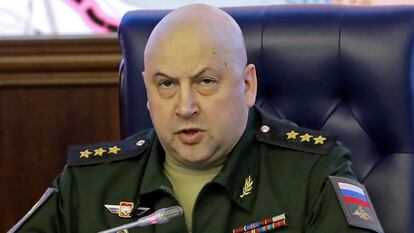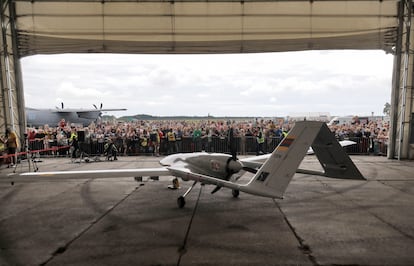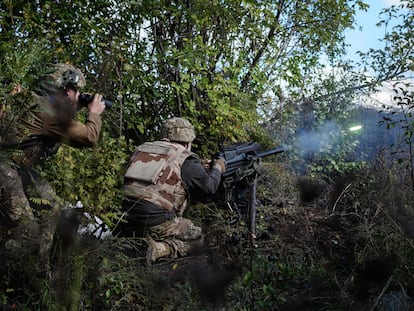Russia’s aerial warfare in Ukraine falters
Drones prove more effective as conventional Russian aircraft fail to penetrate Ukrainian air defenses


Ukrainian authorities denounced Russian bombing in the east and near Kyiv on Saturday, a day after Russian President Vladimir Putin said he didn’t see the need to continue “massive” attacks for the time being. Ukraine’s national energy company warned that the power supply to the capital city and surrounding regions may fail due to severe damage to critical infrastructure. Russian forces also launched at least a dozen missile and drone attacks that damaged energy infrastructure facilities in southeastern Ukraine near Zaporizhzhia, and deployed five Iranian-made drones in the neighboring province of Dnipropetrovsk.
Something else happened in this week in Ukraine, perhaps unprecedented in the field of warfare. Two small reconnaissance drones flying over the Donbas region engaged in close combat at an altitude of 3,300 feet (1,000 meters). When a Russian drone rammed a Ukrainian drone that was recording video of the battlefield, its propeller broke and the device crashed to earth. The symbolic Ukrainian victory in this unusual dogfight represents a complete shift in Moscow’s military strategy brought about by Russia’s failed air war.
The Kremlin has a vast air force including 1,200 fighter jets, among them sophisticated latest-generation machines like the Sukhoi Su-34, Su-35 and Su-37 and Su-34, some of which have been shot down in Ukraine. Russia’s aerial capability dwarfs Ukraine’s combat fleet of around a hundred aircraft, the vast majority of which are Soviet-era MiG-29 and Su-25 planes. However, despite its huge superiority, Russia’s air campaign has failed to make much of an impact on the war in Ukraine.
Russian aircraft only operate over the Donbas region and no longer dare to range further west into Ukrainian territory. In the first two months of the invasion, Russian aircraft were being dropped like flies, shot down by Ukrainian anti-aircraft defenses. According to the Armed Forces of Ukraine, 208 Russian aircraft were shot down between March and May, and another 60 were downed over the next five months. Russian aircraft now only fire at Ukrainian targets from a safe distance hundreds of miles away over Russian territory.
A dictum of modern warfare is that whoever controls the skies wins the battle. That was a successful strategy employed by General Sergei Surovikin, commander of Russia’s Aerospace Forces and the new head of military operations in Ukraine. Surovikini commanded Russian bombing raids in the Syrian civil war to keep dictator Bashar al-Assad - a stauch Russian ally - in power. Two United Nations (UN) officials based in Kyiv with experience on the ground in Syria recently told EL PAÍS: “In Syria, Russian planes roamed freely because there were no air defense systems to stop them; it’s different in Ukraine,”
“If Surovikin fails to replicate his success in Syria, we’re afraid that he’ll start bombing Ukraine indiscriminately from a safe a distance,” said the UN officials, who wished to remain anonymous. They also believe that Russia will continue its massive attacks using missiles and suicide drones launched from aircraft and ground positions in Russia and Belarus.

Mutual air denial
US military experts characterize the air war in Ukraine as a state of “mutual air denial.” Air operations by both sides have been minimal and ineffective. In September, senior US Air Force (USAF) officers attended a seminar sponsored by the Atlantic Council, a Washington think tank. “We thought the Russians would know how to overcome anti-aircraft defenses and coordinate with ground forces, but they haven’t done that,” said Philip Breedlove, a retired four-star general. “This war is very different from what we’ve seen in the past - it’s a war of mutual air denial. It’s like going back to the trenches of World War I.”
The decisive factor has been mobile anti-aircraft batteries. Ukraine has a surface-to-air missile arsenal composed mostly of S-300 launchers, but has also been deploying more advanced units donated by NATO countries. Germany recently delivered the first of four promised IRIS-T SLM batteries (each unit costs $140 million). “Russia’s big mistake has been its failure to neutralize Ukraine’s mobile air defense systems. That’s the main lesson of this war in terms of military tactics,” said Tyson Wetzel, a USAF lieutenant colonel who attended the Atlantic Council seminar.
Anton Mardasov, a military expert with the Middle East Institute and research fellow at the Russian International Affairs Council, describes Ukrainian anti-aircraft tactics: “They have spread their anti-aircraft defense assets out over a large area, and operate in ambush mode by constantly changing positions. The anti-aircraft batteries activate their targeting systems for a short time to quickly engage Russian aircraft, and once they have fired their missiles, they go into silent mode. This makes it hard for the Russians to knock them out, even with anti-radiation missiles [designed to home in on electronic transmissions coming from surface-to-air radar].”
There is more air activity in Donbas. On two recent trips to the Donetsk region, EL PAÍS observed Ukrainian MiGs flying at low altitudes near the frontlines. “The Ukrainian Air Force makes more sorties than people think,” said Justin Bronk, a military expert with the Royal United Services Institute (RUSI), a leading UK defense and security think tank. In September, Bronk posted on social media that since Ukraine lacks air superiority, it operates cautiously by flying low-altitude patrols, attacking Russian anti-aircraft defenses with AGM-88 missiles, and making targeted attacks on frontline positions. But the effectiveness of these tactics has been marginal, he says.
Both sides use helicopters more actively since they are more suitable for short-range operations. But Russia has also lost 240 helicopters in eight months of war, according to the Ukrainian government. Bronk says that international shipments of weapons to Ukraine like the SA-11 (Gadfly) medium-range missiles, German-made Gepard tanks, and portable rocket launchers have been especially effective against Russian helicopters.
Russia has employed the same mobility-focused strategy, which is why NATO leaders do not favor supplying Ukraine with combat aircraft. Bronk says that another drawback of this type of aircraft is that they need a steady supply of munitions, repair parts, and logistical support that would be difficult to provide in Ukraine. He believes it would be better to supply Ukrainian aircraft with European air-to-air missiles so they can shoot down Russia’s long-range missiles and drones.

The drone era
“Aerial warfare has become cheaper and air superiority will probably be more difficult to achieve in the future,” says Wetzel. Mobile anti-aircraft systems and drones are the reason it has become cheaper, and unmanned aerial vehicles have been more effective than conventional fighters in this war. Large drone fleets are already operating in Ukraine, says the USAF officer. Russia launches dozens of Iranian-made Shahed long-range “suicide” drones every day, as well as its own Lancet drones. Ukraine countered by destroying two Russian bombers with a suicide drone attack on an air base in Russian territory on October 8. Over the summer, Ukraine used kamikaze drones to attack Russian fleet headquarters in Crimea. But these suicide drone attacks are akin to missile launches and are not a substitute for combat aircraft. Drones like the Turkish-made Bayraktar are operated by highly trained pilots, and have become a star performer in Ukraine’s arsenal. Russia has a similar capability in the Mohajer-6.
There is plenty of opportunity to use drones to surprise the enemy in this war. Ukraine has even modified commercial drones to drop bombs on Russian positions. The war in Ukraine has changed aerial warfare for good, as EL PAÍS was able to witness in August while reporting from the frontlines in Dnipro and Kherson. Soldiers from Ukraine’s 98th tactical battalion told this newspaper that what they feared most was spotting one of Russia’s small reconnaissance drones - modified commercial units redeployed to drop bombs.
Tu suscripción se está usando en otro dispositivo
¿Quieres añadir otro usuario a tu suscripción?
Si continúas leyendo en este dispositivo, no se podrá leer en el otro.
FlechaTu suscripción se está usando en otro dispositivo y solo puedes acceder a EL PAÍS desde un dispositivo a la vez.
Si quieres compartir tu cuenta, cambia tu suscripción a la modalidad Premium, así podrás añadir otro usuario. Cada uno accederá con su propia cuenta de email, lo que os permitirá personalizar vuestra experiencia en EL PAÍS.
¿Tienes una suscripción de empresa? Accede aquí para contratar más cuentas.
En el caso de no saber quién está usando tu cuenta, te recomendamos cambiar tu contraseña aquí.
Si decides continuar compartiendo tu cuenta, este mensaje se mostrará en tu dispositivo y en el de la otra persona que está usando tu cuenta de forma indefinida, afectando a tu experiencia de lectura. Puedes consultar aquí los términos y condiciones de la suscripción digital.
More information
Últimas noticias
Most viewed
- Reinhard Genzel, Nobel laureate in physics: ‘One-minute videos will never give you the truth’
- Oona Chaplin: ‘I told James Cameron that I was living in a treehouse and starting a permaculture project with a friend’
- Pablo Escobar’s hippos: A serious environmental problem, 40 years on
- Why we lost the habit of sleeping in two segments and how that changed our sense of time
- Chevy Chase, the beloved comedian who was a monster off camera: ‘Not everyone hated him, just the people who’ve worked with him’










































